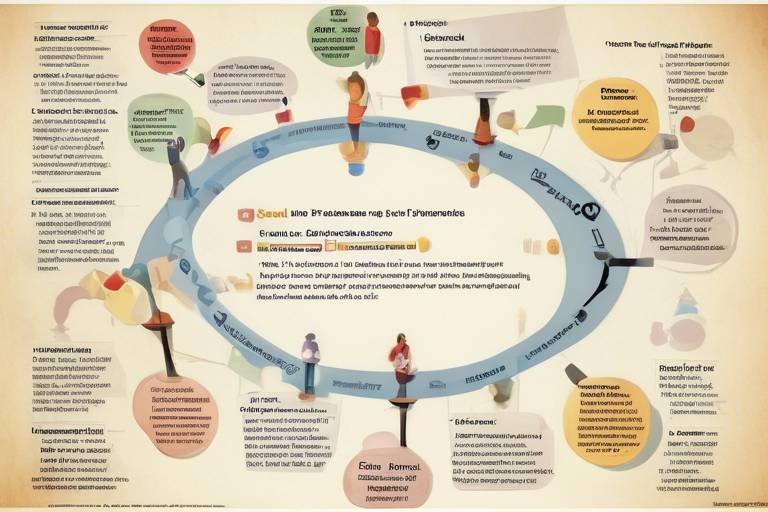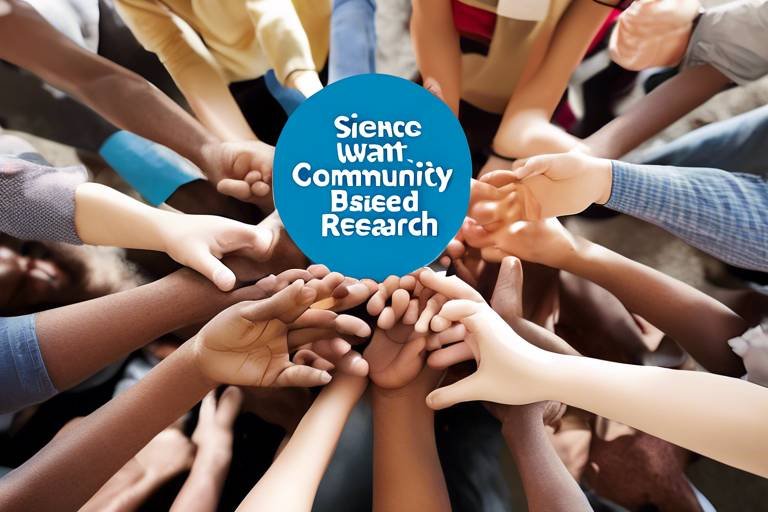The Benefits of Utilizing Social Capital in Research Design
In the ever-evolving landscape of research, the integration of social capital has emerged as a transformative force. But what exactly does this mean for researchers? Imagine a world where the connections you foster can unlock doors to new ideas, diverse perspectives, and innovative methodologies. Utilizing social capital in research design is not just a trend; it's a necessity that can significantly enhance the quality and impact of research outcomes.
Social capital encompasses the networks, relationships, and norms that facilitate cooperation among individuals and groups. This concept plays a crucial role in fostering trust and collaboration in research environments. By leveraging social capital, researchers can tap into a wealth of resources and insights that may otherwise remain untapped. Think of it as a treasure chest filled with valuable information, waiting to be discovered through connections with others.
One of the most profound benefits of utilizing social capital is the access it provides to diverse perspectives. When researchers engage with a variety of stakeholders, including community members, policymakers, and fellow academics, they can enrich their research design. This diversity not only broadens the scope of the research but also ensures that the findings are more applicable to real-world scenarios. It's like adding vibrant colors to a painting; the more hues you incorporate, the more captivating the final piece will be.
Moreover, social capital fosters a collaborative spirit, which is essential for tackling complex research questions. By pooling resources and expertise, researchers can embark on collaborative research initiatives that lead to more robust outcomes. This collaboration can manifest in various forms, such as joint studies, interdisciplinary projects, and community engagement efforts. Engaging with others allows researchers to share the burden of research challenges while simultaneously amplifying the impact of their findings.
However, while the advantages of social capital are clear, researchers must also navigate the challenges that come with it. For instance, unequal access to networks can create disparities in research opportunities. To address these inequalities, researchers need to be proactive in ensuring that all voices are represented in the research process. This might involve reaching out to underrepresented communities or forming alliances with organizations that prioritize inclusivity.
Additionally, researchers must remain vigilant about potential biases that may arise from their social networks. Just as a lens can distort an image, personal connections can influence research outcomes. It's essential for researchers to strive for objectivity and inclusivity, thereby enhancing the credibility of their work. By acknowledging these biases and taking steps to mitigate them, researchers can ensure that their findings are not only valid but also reflective of a broader spectrum of perspectives.
In practical terms, the application of social capital in research design can lead to innovative methodologies and improved stakeholder engagement. For instance, community-based participatory research is a prime example of how social capital can be harnessed to foster active collaboration between researchers and community members. This approach not only addresses local issues effectively but also empowers communities by involving them in the research process.
Ultimately, the benefits of utilizing social capital in research design are manifold. From enhanced collaboration to richer research outcomes, the potential is vast. As we continue to explore the significance of social capital, it becomes increasingly clear that fostering connections and building relationships will be key to driving impactful research in the future.
- What is social capital?
Social capital refers to the networks, relationships, and norms that facilitate cooperation among individuals and groups.
- How does social capital enhance research design?
It provides access to diverse perspectives, resources, and expertise, leading to more comprehensive and impactful research outcomes.
- What are the types of social capital?
There are three main types: bonding, bridging, and linking social capital, each contributing uniquely to research dynamics.
- What challenges do researchers face when leveraging social capital?
Challenges include unequal access to networks, potential biases, and the need for effective communication strategies.

Understanding Social Capital
Social capital is a multifaceted concept that encompasses the networks, relationships, and norms that facilitate cooperation among individuals and groups. Think of it as the invisible glue that holds communities together, fostering an environment where trust and collaboration can flourish. In the context of research design, social capital plays a crucial role in enhancing the quality and impact of research outcomes. It’s like having an all-access pass to a treasure trove of insights, experiences, and resources that can significantly elevate the research process.
At its core, social capital is about the connections we make and the relationships we build. These relationships can be categorized into three main types: bonding, bridging, and linking. Each type serves a different purpose and contributes uniquely to the dynamics of research collaboration. For instance, bonding social capital strengthens ties within close-knit groups, while bridging social capital connects diverse groups, opening the door to new ideas and perspectives.
Imagine you’re working on a research project about community health. If you only rely on your immediate circle of colleagues, you might miss out on valuable insights from community members or health practitioners outside your network. This is where social capital shines, as it allows researchers to tap into a wider array of voices and experiences, ultimately leading to a more comprehensive understanding of the subject matter.
Moreover, social capital is not just about the quantity of connections but also the quality. Strong, trusting relationships can lead to more effective collaboration, where stakeholders feel comfortable sharing their ideas and resources. This is particularly important in research settings, where the complexity of issues often requires a collaborative approach to problem-solving.
In summary, understanding social capital is fundamental for researchers aiming to enhance their work’s relevance and impact. By leveraging the networks and relationships they build, researchers can access diverse perspectives and resources, ultimately leading to richer and more meaningful research outcomes. So, the next time you embark on a research journey, consider how you can harness the power of social capital to elevate your work and make a lasting impact.
- What is social capital? - Social capital refers to the networks, relationships, and norms that facilitate cooperation among individuals and groups.
- Why is social capital important in research? - It enhances research quality by providing access to diverse perspectives and resources, fostering collaboration.
- What are the types of social capital? - The three main types are bonding, bridging, and linking social capital.
- How can researchers leverage social capital? - Researchers can engage with diverse groups, collaborate on initiatives, and build strong relationships to enhance their research outcomes.

The Role of Social Capital in Research
Social capital plays a pivotal role in enhancing research design and outcomes. By fostering connections and networks among researchers, practitioners, and communities, social capital opens up a treasure trove of resources and insights that can significantly enrich the research process. Imagine embarking on a journey without a map; that's what conducting research without social capital can feel like. It’s the connections that guide researchers to new ideas, methodologies, and collaborations that they might not have encountered otherwise.
One of the most exciting aspects of social capital is how it provides access to diverse perspectives. When researchers tap into their networks, they can gather insights from individuals with varied backgrounds and experiences. This diversity can lead to more innovative solutions and a deeper understanding of the research topic. For example, a study on public health may benefit from input not only from medical professionals but also from community leaders, patients, and even artists who can offer unique viewpoints on health communication.
Moreover, social capital facilitates the sharing of resources. Researchers often operate within tight budgets and limited time frames. However, by leveraging their social networks, they can access resources such as funding opportunities, research materials, and even manpower. Collaborating with others can lead to pooling resources, which not only enhances the quality of research but also reduces individual burdens. Think of it as a potluck dinner where everyone brings a dish, resulting in a more diverse and satisfying meal than any one person could provide on their own.
Additionally, social capital enhances the credibility and legitimacy of research findings. When researchers collaborate with respected individuals or organizations within their field, their work gains recognition and trust. This is crucial, especially in fields where public perception is key. For instance, a study on environmental sustainability conducted in partnership with a well-known environmental organization may be viewed more favorably than one conducted in isolation. The endorsement from established networks can serve as a powerful validation of the research efforts.
However, it’s important to remember that the role of social capital in research is not merely about gaining access to information or resources. It also involves fostering an environment of collaboration and support. Researchers who actively engage with their networks can create a culture of mutual assistance, where knowledge is freely exchanged, and ideas are collaboratively developed. This dynamic can lead to innovative methodologies and approaches that may not have emerged in a more isolated research setting.
In summary, the role of social capital in research is multifaceted and invaluable. By enhancing access to diverse perspectives, sharing resources, boosting credibility, and fostering collaboration, social capital enriches the research landscape. It transforms research from a solitary endeavor into a community-driven initiative, ultimately leading to more comprehensive and impactful outcomes.
- What is social capital? Social capital refers to the networks, relationships, and norms that facilitate cooperation among individuals and groups, fostering trust and collaboration.
- How does social capital enhance research? It provides access to diverse perspectives, resources, and expertise, leading to more comprehensive and impactful research outcomes.
- What are the types of social capital? The three main types are bonding, bridging, and linking social capital, each contributing uniquely to research dynamics.
- What challenges might researchers face with social capital? Researchers may encounter issues such as unequal access to networks, potential biases, and the need for effective communication strategies.

Types of Social Capital
When we dive into the concept of social capital, it's essential to recognize that it's not a one-size-fits-all phenomenon. Instead, it can be categorized into three distinct types: bonding social capital, bridging social capital, and linking social capital. Each of these types plays a unique role in shaping the dynamics of research collaboration and outcomes.
Bonding social capital is all about the close-knit relationships that form among individuals within a specific group. Think of it as the glue that holds a family together or the camaraderie among a tight circle of friends. In research, bonding social capital fosters a strong sense of trust and support, which can significantly enhance the depth of qualitative findings. For instance, when researchers have strong ties with their colleagues, they can share insights and experiences more freely, leading to richer data collection and interpretation.
On the other hand, bridging social capital connects individuals from diverse backgrounds and groups. It’s like a bridge spanning across different islands, allowing for the flow of new ideas and perspectives. This type of social capital is crucial in research design because it encourages collaboration beyond the immediate circle of colleagues. By engaging with people from various disciplines, researchers can tap into innovative methodologies and broaden the applicability of their findings. For example, a researcher studying public health might collaborate with social scientists, economists, and community leaders, resulting in a more holistic approach to tackling health issues.
Finally, we have linking social capital, which refers to connections that cross different social strata. Imagine a ladder where each rung represents a different level of influence or power in society. Linking social capital allows researchers to engage with influential stakeholders and policymakers, enhancing the relevance and impact of their work. By building relationships with these key players, researchers can ensure that their findings reach a wider audience and contribute to meaningful change. For instance, a study on educational reform may involve collaboration with school administrators, government officials, and community organizations, ultimately leading to policies that benefit students.
In summary, understanding the different types of social capital is vital for researchers looking to enrich their work. By recognizing the unique contributions of bonding, bridging, and linking social capital, researchers can strategically leverage these connections to enhance collaboration, foster innovation, and increase the overall impact of their research.
- What is social capital? Social capital refers to the networks, relationships, and norms that facilitate cooperation among individuals and groups.
- Why is social capital important in research? It provides access to diverse perspectives, resources, and expertise, leading to more comprehensive research outcomes.
- What are the three types of social capital? The three types are bonding, bridging, and linking social capital.
- How can researchers overcome challenges related to social capital? By proactively addressing access inequalities and being aware of potential biases, researchers can maximize the benefits of social capital.

Bonding Social Capital
Bonding social capital is like the glue that holds close-knit groups together. It refers to the strong ties and relationships that develop among individuals who share similar backgrounds, interests, or experiences. Think of it as the cozy neighborhood where everyone knows each other, shares resources, and supports one another. In the context of research design, bonding social capital can significantly enhance the depth and quality of qualitative research findings. When researchers tap into these strong connections, they can gain insights that are often overlooked in more superficial studies.
One of the key benefits of bonding social capital is the trust that naturally develops within these tight circles. Trust fosters open communication, which is essential for gathering honest and nuanced data. When participants feel comfortable and valued, they are more likely to share their true thoughts and feelings, leading to richer qualitative data. This is particularly important in sensitive research areas, where participants may be hesitant to speak up unless they feel a sense of belonging and safety.
Moreover, bonding social capital allows researchers to mobilize resources effectively. When researchers are embedded within a community or a specific group, they can leverage existing networks to access participants, gather data, and disseminate findings. This kind of collaboration can lead to innovative approaches to research that might not have been possible otherwise. For instance, a researcher studying health outcomes in a tight-knit community can work with local leaders to ensure that the research is culturally relevant and ethically sound.
However, it's important to recognize that while bonding social capital has its advantages, it can also create an echo chamber effect. This occurs when the strong ties within a group lead to homogenized thinking, where everyone shares similar viewpoints and experiences. To mitigate this risk, researchers should actively seek out diverse perspectives, even within their close networks. By doing so, they can enrich their research and ensure that it reflects a broader range of experiences and ideas.
In summary, bonding social capital is a powerful tool in research design, offering depth, trust, and resource mobilization. By leveraging these strong ties, researchers can enhance the quality of their work and foster more meaningful connections with their participants. However, maintaining a balance between strong ties and diverse perspectives is crucial to avoid the pitfalls of groupthink.
- What is bonding social capital?
Bonding social capital refers to the strong ties and relationships among individuals within a close-knit group, which fosters trust and support. - How does bonding social capital benefit research?
It enhances the depth of qualitative research findings by promoting open communication and trust among participants. - Can bonding social capital lead to biases?
Yes, it can create an echo chamber effect, where diverse perspectives may be overlooked. Researchers should strive to include a variety of viewpoints.

Bridging Social Capital
Bridging social capital is like a bridge that connects different islands of knowledge, ideas, and experiences. Imagine you are at a party where everyone knows each other really well, but they all belong to different groups. This is where bridging social capital comes into play—it links these diverse groups, allowing individuals to share resources, insights, and perspectives that might not be available within their own circles. This kind of social capital is crucial in research design because it opens the door to a wider range of viewpoints and expertise, ultimately enriching the research process.
When researchers tap into bridging social capital, they can access a wealth of information that transcends the boundaries of their immediate network. For example, a researcher studying urban development might connect with environmentalists, community activists, and local government officials. Each of these groups brings unique insights that can lead to a more comprehensive understanding of the issues at hand. By fostering these connections, researchers can create a tapestry of knowledge that is far more intricate and informative than any single perspective could provide.
Furthermore, bridging social capital encourages innovation. When different ideas collide, it often sparks creativity and novel solutions. Think of it as a melting pot where various ingredients combine to create a delicious dish. In research, this means that by engaging with diverse groups, researchers can develop methodologies that are not only innovative but also more relevant to the communities they aim to serve.
However, leveraging bridging social capital is not without its challenges. Researchers must be intentional about building and maintaining these connections. It requires active participation and a willingness to engage with people outside of one's comfort zone. For instance, attending community meetings, joining interdisciplinary conferences, or collaborating with organizations in different sectors can be effective strategies for cultivating these relationships.
In summary, bridging social capital acts as a vital conduit for collaboration and innovation in research. By forming connections across diverse groups, researchers can enhance the quality and impact of their work, ensuring that it resonates with a broader audience. This not only strengthens the research itself but also fosters a sense of community and shared purpose, ultimately leading to more effective solutions to complex problems.
- What is bridging social capital? Bridging social capital refers to the connections that link diverse groups, facilitating the exchange of ideas and resources.
- Why is bridging social capital important in research? It enhances research by providing access to a wider range of perspectives, leading to more comprehensive and impactful outcomes.
- How can researchers build bridging social capital? Researchers can engage in community events, interdisciplinary conferences, and collaborative projects to foster these connections.

Linking Social Capital
Linking social capital is a fascinating aspect of social networks that extends beyond the familiar circles of friends and family. It involves the connections that bridge different social strata, allowing individuals to engage with influential stakeholders, policymakers, and organizations. Imagine a researcher standing at the intersection of various communities, reaching out to those who hold the power to enact change. This is where linking social capital shines, as it opens doors to resources and opportunities that would otherwise remain inaccessible.
One of the primary benefits of linking social capital is its ability to enhance the relevance and impact of research. When researchers establish connections with policymakers or community leaders, they gain insights that can shape their projects to better address real-world issues. This engagement not only enriches the research but also ensures that the findings are more likely to be implemented in practice. For instance, a study on urban health can be significantly influenced by collaboration with local health departments, thereby increasing its applicability and societal impact.
Moreover, linking social capital can facilitate the exchange of knowledge across sectors. Researchers who connect with industry experts or government officials can access valuable data, methodologies, and best practices that may not be available in academic circles. This cross-pollination of ideas can lead to innovative research designs and methodologies that are both practical and impactful. For example, a researcher studying climate change may collaborate with environmental policy experts, gaining insights that help frame their research within the context of current legislation and community needs.
However, it’s important to recognize that building linking social capital requires intentional effort and strategic planning. Researchers should actively seek out opportunities to network beyond their immediate academic circles. Participating in conferences, engaging in community forums, or even leveraging social media platforms can be effective ways to foster these essential connections. By doing so, researchers not only enhance their own work but also contribute to a more interconnected and collaborative research environment.
In summary, linking social capital is a crucial component of effective research design. It empowers researchers to engage with diverse stakeholders, enriches their projects with varied perspectives, and ultimately enhances the societal relevance of their work. As the research landscape continues to evolve, embracing linking social capital will be essential for driving impactful change and fostering innovation.
- What is linking social capital? Linking social capital refers to the connections that individuals establish with influential stakeholders across different social strata, enhancing access to resources and opportunities.
- How does linking social capital benefit research? It provides researchers with valuable insights, promotes the applicability of their findings, and fosters collaboration across sectors, leading to more impactful outcomes.
- What are some ways to build linking social capital? Researchers can build linking social capital by participating in conferences, engaging with community leaders, and utilizing social media to connect with diverse stakeholders.

Challenges in Leveraging Social Capital
While the advantages of leveraging social capital in research design are compelling, it’s crucial to recognize that there are also significant challenges that researchers must navigate. One of the most pressing issues is the unequal access to networks. Not everyone has the same opportunities to build relationships or tap into valuable resources. This disparity can skew research outcomes, as certain voices may dominate the conversation while others are left unheard. Imagine trying to complete a puzzle but only having access to a few pieces; that’s what it feels like when researchers lack access to diverse social networks.
Another challenge is the potential for biases that can arise from social capital dynamics. Researchers might unconsciously favor information or perspectives that align with their existing networks, leading to a narrow view of the research topic. This can hinder the overall quality of the research and its applicability to broader contexts. It’s like having a favorite flavor of ice cream—while it’s delicious, it doesn’t represent the full range of options available. Researchers need to be vigilant and strive for objectivity, ensuring that their work reflects a wider spectrum of insights and experiences.
Effective communication strategies are also essential in overcoming these challenges. Researchers must be able to articulate their goals and engage with diverse stakeholders in a way that fosters collaboration. This can often be a daunting task, especially when stakeholders come from different backgrounds with varying levels of familiarity with the research topic. To facilitate better communication, researchers can employ strategies such as:
- Creating inclusive dialogue platforms
- Utilizing visual aids to convey complex information
- Encouraging feedback and open-ended discussions
By implementing these strategies, researchers can enhance their ability to engage with a broader audience, ultimately enriching their research outcomes. However, it’s important to remember that addressing these challenges requires ongoing effort and commitment. Researchers must be proactive in identifying access inequalities, mitigating biases, and fostering effective communication to truly harness the power of social capital in their work.
Q: What is social capital?
A: Social capital refers to the networks, relationships, and norms that facilitate cooperation among individuals and groups. It plays a vital role in fostering trust and collaboration in various environments, including research.
Q: How can social capital enhance research outcomes?
A: By providing access to diverse perspectives, resources, and expertise, social capital can lead to more comprehensive and impactful research outcomes.
Q: What are some challenges associated with social capital?
A: Challenges include unequal access to networks, potential biases in research, and the need for effective communication strategies to maximize collaboration.
Q: How can researchers address inequalities in access to social capital?
A: Researchers can be proactive in identifying and addressing access inequalities by ensuring that all voices and perspectives are represented in the research process.

Addressing Access Inequalities
In the realm of research, the concept of social capital can be a double-edged sword. While it has the potential to enrich research outcomes, it can also create barriers for certain groups. Unequal access to networks and resources can hinder the participation of underrepresented voices, which ultimately skews research findings and limits the applicability of results. So, how can researchers tackle these inequalities? It's all about being proactive and intentional in our approach.
First and foremost, researchers should actively seek to identify gaps in access to social capital. This means taking a hard look at who is involved in the research process and asking critical questions like: Are we including diverse perspectives? Are we reaching out to communities that have historically been marginalized? By acknowledging these gaps, researchers can begin to formulate strategies that promote inclusivity.
One effective strategy is to build partnerships with community organizations that already have established trust and rapport within underrepresented groups. These organizations can serve as vital bridges, facilitating access to populations that researchers may not have direct connections with. By collaborating with these groups, researchers can ensure that their studies reflect a more comprehensive range of experiences and insights.
Moreover, providing training and resources for researchers on the importance of equity in research design is crucial. This can include workshops that focus on cultural competency and effective communication strategies. When researchers understand the unique challenges faced by different communities, they can tailor their approaches to be more inclusive. For instance, using community feedback to shape research questions can lead to more relevant and impactful studies.
Additionally, leveraging technology can help bridge access gaps. Digital platforms can be utilized for outreach, allowing researchers to connect with a broader audience. Social media, webinars, and online surveys can provide alternative avenues for participation, especially for individuals who may not be able to attend in-person meetings. However, it is essential to consider the digital divide and ensure that all potential participants have the necessary access to technology.
Lastly, researchers must commit to ongoing evaluation of their efforts to address access inequalities. This means regularly assessing who is being included in their research and making adjustments as needed. By maintaining a flexible and responsive approach, researchers can continually improve their practices to foster a more equitable research environment.
- What is social capital? Social capital refers to the networks, relationships, and norms that enable cooperation among individuals and groups.
- Why is addressing access inequalities important in research? Addressing access inequalities ensures that diverse perspectives are included, which leads to more comprehensive and impactful research outcomes.
- How can researchers build partnerships with community organizations? Researchers can reach out to local organizations, attend community meetings, and engage in dialogue to build trust and collaboration.
- What role does technology play in addressing access inequalities? Technology can facilitate outreach and engagement, allowing researchers to connect with diverse populations through digital platforms.

Mitigating Biases
When it comes to research, bias can be a sneaky little devil that undermines the integrity and credibility of your findings. It's like a shadow lurking in the corners, ready to distort the truth. This is especially true when we talk about social capital, where the relationships and networks we form can unintentionally lead to skewed perspectives. To truly harness the power of social capital, researchers must be vigilant in identifying and mitigating these biases. But how do we go about this? Let's break it down.
First off, it's essential to recognize that biases can stem from various sources. They can arise from personal relationships, cultural backgrounds, or even institutional affiliations. For example, if a researcher primarily collaborates with a specific group of individuals, they might inadvertently overlook alternative viewpoints or data that could be critical to their research. This is where the concept of diversity comes into play. By ensuring a diverse range of voices and perspectives are included in the research process, researchers can create a more balanced and comprehensive view.
Here are a few strategies to mitigate biases effectively:
- Engage in Reflective Practice: Regularly assess your own biases and assumptions. This can be done through journaling or discussions with peers.
- Diverse Collaboration: Actively seek out collaborators from different backgrounds, disciplines, and experiences to enrich your research perspective.
- Transparent Methodologies: Clearly outline your research methods and decision-making processes. Transparency can help others understand your approach and identify potential biases.
- Feedback Mechanisms: Establish channels for feedback from a broad audience, including those outside your immediate network. This can help uncover blind spots.
Additionally, it’s important to create an environment where open dialogue is encouraged. Researchers should foster a culture of inclusivity where all participants feel comfortable sharing their thoughts and concerns. This not only enriches the research process but also helps in identifying biases that may not have been apparent initially.
Lastly, staying informed about the latest developments in research ethics and bias mitigation techniques is crucial. Engaging with literature, attending workshops, and participating in discussions about bias can equip researchers with the tools they need to minimize its impact. Remember, the goal is to strive for objectivity and inclusivity, ensuring that the research reflects a wide array of experiences and viewpoints.
- What is social capital? Social capital refers to the networks, relationships, and norms that facilitate cooperation among individuals and groups.
- How does social capital impact research? It enhances research by providing access to diverse perspectives, resources, and expertise, leading to more comprehensive outcomes.
- What are the types of social capital? The three main types are bonding, bridging, and linking social capital, each contributing uniquely to research dynamics.
- How can biases be mitigated in research? By engaging in reflective practice, promoting diverse collaboration, ensuring transparent methodologies, and establishing feedback mechanisms.

Practical Applications of Social Capital
Utilizing social capital in research design is not just a theoretical concept; it has real-world implications that can transform how we approach various studies. When researchers tap into the networks, relationships, and shared norms within their communities, they unlock a treasure trove of resources and insights. This can lead to innovative methodologies that not only enhance the quality of research but also ensure that findings resonate with the broader community.
One of the most compelling practical applications of social capital is seen in collaborative research initiatives. By pooling resources, knowledge, and expertise, researchers can create a synergy that elevates the research process. Imagine a group of scientists from different disciplines coming together to tackle climate change. Each member brings unique perspectives and skills, leading to more robust and impactful outcomes. This collaboration not only enriches the research but also fosters a sense of community and shared purpose among the participants.
Another noteworthy application is found in community-based participatory research (CBPR). This approach exemplifies how social capital can be harnessed to create meaningful change. In CBPR, researchers work hand-in-hand with community members to identify local issues and develop solutions. This partnership ensures that the research is not only relevant but also culturally sensitive and applicable to the community's specific needs. For instance, a study aimed at improving public health might involve local residents in the design and implementation of the research, leading to higher engagement and better outcomes.
Moreover, engaging with social capital enhances the dissemination of findings. When researchers build strong relationships with stakeholders, they can more effectively share their results and recommendations. This is crucial because research is only as valuable as its ability to influence practice and policy. For example, researchers who establish connections with local government officials can ensure that their findings inform public policy decisions, thereby amplifying the impact of their work.
To illustrate the impact of social capital in research, consider the following table:
| Application | Description | Benefits |
|---|---|---|
| Collaborative Research Initiatives | Pooling resources and expertise from diverse researchers. | Enhanced outcomes, innovative solutions, and stronger community ties. |
| Community-Based Participatory Research | Engaging community members in the research process. | Increased relevance, cultural sensitivity, and community ownership. |
| Effective Dissemination | Building relationships with stakeholders for sharing findings. | Greater influence on policy and practice, broader reach of research. |
In summary, the practical applications of social capital in research design are vast and varied. By leveraging these connections, researchers can create studies that are not only methodologically sound but also deeply impactful. The collaboration and engagement fostered through social capital can lead to innovative solutions that address pressing societal issues, ultimately benefiting both the academic community and the public at large.
- What is social capital? Social capital refers to the networks and relationships that enable individuals and groups to work together effectively.
- How does social capital enhance research? It provides access to diverse perspectives, resources, and expertise, leading to more comprehensive research outcomes.
- What are the types of social capital? The three main types are bonding, bridging, and linking social capital.
- What are some challenges in leveraging social capital? Challenges include unequal access to networks and potential biases in research.
- How can researchers mitigate biases associated with social capital? By being aware of potential biases and striving for inclusivity in their research design.

Collaborative Research Initiatives
Collaborative research initiatives are a powerful way to harness the collective strength of social capital. By bringing together diverse groups of researchers, community members, and stakeholders, these initiatives create a rich tapestry of knowledge and perspectives that can lead to groundbreaking discoveries. Imagine a potluck dinner where everyone brings their favorite dish; similarly, in collaborative research, each participant contributes their unique expertise, insights, and resources, resulting in a feast of information that is far more satisfying than any single dish could provide.
One of the key advantages of collaborative research is the ability to address complex problems from multiple angles. For instance, consider a project focused on public health. By involving healthcare professionals, social workers, and community leaders, researchers can gain a more holistic understanding of the issues at hand. This interdisciplinary approach allows for the identification of innovative solutions that may not have been evident when working in isolation. Furthermore, the collaborative nature fosters a sense of ownership among all participants, which can enhance motivation and commitment to the research objectives.
However, successful collaborative research initiatives require effective communication and trust among all parties involved. Establishing clear goals, roles, and expectations from the outset can help mitigate misunderstandings and ensure that everyone is on the same page. Regular meetings and open channels of communication are essential for maintaining momentum and addressing any challenges that may arise. In this way, social capital acts as the glue that holds the initiative together, enabling participants to work harmoniously towards a common goal.
Moreover, the benefits of collaborative research extend beyond just the immediate project. The relationships built during these initiatives often lead to long-term partnerships that can enhance future research endeavors. Researchers who have collaborated in the past are more likely to work together again, creating a network of trust and shared knowledge that can significantly improve the quality and impact of subsequent projects.
To illustrate the impact of collaborative research initiatives, consider the following table showcasing some notable examples:
| Research Initiative | Field | Outcome |
|---|---|---|
| Community Health Partnerships | Public Health | Improved access to healthcare services in underserved areas |
| Urban Sustainability Projects | Environmental Science | Innovative solutions for waste management and green spaces |
| Education Reform Collaboratives | Education | Enhanced curriculum and teaching strategies through community engagement |
In conclusion, collaborative research initiatives are not just a trend; they are a necessity in today’s interconnected world. By leveraging social capital, researchers can create a dynamic environment that fosters innovation, inclusivity, and impactful outcomes. The collective wisdom of diverse teams can lead to solutions that are not only effective but also sustainable, ensuring that research benefits the broader community and addresses real-world challenges.
- What is social capital? Social capital refers to the networks, relationships, and norms that facilitate cooperation among individuals and groups.
- How does social capital enhance research? It provides access to diverse perspectives, resources, and expertise, leading to more comprehensive research outcomes.
- What are the types of social capital? The three main types are bonding, bridging, and linking social capital, each contributing uniquely to research dynamics.
- What challenges might researchers face in leveraging social capital? Challenges include unequal access to networks, potential biases, and the need for effective communication strategies.
- How can I get involved in collaborative research initiatives? Look for local universities, community organizations, or research networks that focus on collaborative projects in your area of interest.

Community-Based Participatory Research
Community-Based Participatory Research (CBPR) is a dynamic approach that actively involves community members in the research process. This method emphasizes the importance of collaboration between researchers and the communities they study, ensuring that the research is not only relevant but also beneficial to those directly impacted by the findings. Imagine a bridge connecting researchers and community members, where both parties walk together, sharing insights and experiences to create a more comprehensive understanding of local issues. This partnership fosters a sense of ownership and empowerment among community members, allowing them to contribute their unique perspectives and knowledge.
One of the standout features of CBPR is its focus on addressing real-world problems that communities face. By engaging stakeholders from the very beginning, researchers can tailor their studies to reflect the specific needs and priorities of the community. This approach not only enhances the validity of the research but also increases the likelihood that the findings will be implemented effectively. For instance, if a community is grappling with high rates of diabetes, researchers can work alongside local health advocates to design interventions that are culturally appropriate and practically feasible.
Moreover, CBPR promotes trust and transparency, which are essential for successful collaboration. When community members are involved in the research process, they are more likely to trust the researchers and the results produced. This trust can lead to a richer exchange of information, as community members feel more comfortable sharing their experiences and concerns. Additionally, the collaborative nature of CBPR helps to mitigate power imbalances that often exist in traditional research settings, where researchers may hold all the authority and decision-making power.
To illustrate the impact of CBPR, consider the following table that outlines its key benefits:
| Benefit | Description |
|---|---|
| Enhanced Relevance | Research is directly aligned with community needs and priorities. |
| Increased Trust | Building rapport between researchers and community members fosters a collaborative environment. |
| Empowerment | Community members gain skills and knowledge, enhancing their capacity to address local issues. |
| Sustainable Solutions | Findings are more likely to be implemented effectively when community members are involved. |
In summary, Community-Based Participatory Research is more than just a methodology; it is a philosophy that values the voices of those who are often overlooked in traditional research. By embracing this approach, researchers can create impactful, community-driven studies that not only advance knowledge but also promote social change. The journey of research becomes a collective endeavor, where every voice matters, and every insight contributes to a greater understanding of the community's needs.
- What is Community-Based Participatory Research?
CBPR is a collaborative approach that involves community members in the research process, ensuring that the research is relevant and beneficial to the community. - How does CBPR differ from traditional research?
Unlike traditional research, which often excludes community input, CBPR actively engages community members, fostering a partnership that enhances the research's impact. - What are the benefits of CBPR?
CBPR enhances relevance, builds trust, empowers community members, and leads to sustainable solutions that address local issues effectively.
Frequently Asked Questions
- What is social capital and why is it important in research design?
Social capital refers to the networks, relationships, and norms that enable cooperation among individuals and groups. In research design, it is crucial because it fosters trust and collaboration, allowing researchers to access diverse perspectives and resources, ultimately leading to more comprehensive and impactful outcomes.
- What are the different types of social capital?
There are three main types of social capital: bonding, bridging, and linking. Bonding social capital focuses on strong ties within close-knit groups, bridging social capital connects diverse groups for new ideas, and linking social capital engages with different social strata, enhancing the relevance of research through connections with influential stakeholders.
- What challenges might researchers face when leveraging social capital?
Researchers may encounter challenges such as unequal access to networks, potential biases affecting objectivity, and the need for effective communication strategies. Addressing these challenges is essential to ensure that all voices and perspectives are represented in the research process.
- How can researchers address access inequalities in social capital?
To tackle access inequalities, researchers should actively identify gaps in networks and work towards inclusivity. This means engaging with underrepresented groups and ensuring that their perspectives are included in the research design and implementation.
- What are some practical applications of social capital in research?
Utilizing social capital can lead to innovative methodologies, improved stakeholder engagement, and enhanced dissemination of findings. For example, collaborative research initiatives pool resources and knowledge, while community-based participatory research fosters active collaboration between researchers and community members to effectively address local issues.



















